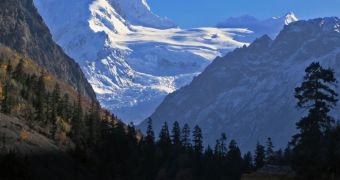Many experts believe that the Himalayas are the tallest mountains to have existed on Earth over the past 50 million years. They are growing even now, in fact, and researchers became curious as to how this growth process will come to an end. A new paper sheds some light on these aspects.
The main theory explaining the formation of volcanoes, mountains, plateaus and the triggering of earthquakes is called plate tectonics, and it has been around for about 50 years. Geologists always operate under its guidance, so to speak.
Some time ago, experts figured out that the Himalayas and the Tibetan Plateau are the result of huge collision, between the Indian plate and the Eurasian plate. When this event began, the world's tallest mountains were literally thrust out of the ground.
This growth process occurred relatively fast (in geological terms), but is now slowing down. Scientists have been trying to figure out the factors that contribute to this decrease in growth speed. University of Michigan geomorphologist and geophysicist Marin Clark recently made some headway in this regard.
In a paper published in the February 29 online issue of the top scientific journal Nature, the expert proposes that the most important factor is not the height of the mountain itself, as many colleagues had suggested. Instead, the strength of the underlying mantle appears to play a more important role.
“The exciting thing here is that it's not easy to make progress in a field (plate tectonics) that's 50 years old and is the major tenet that we operate under,” says the expert, who holds an appointment as an assistant professor in the U-M Department of Earth and Environmental Sciences.
She adds that her paper is basically revealing when the growth process will stop altogether, as well as the reasons why it's slowing down in the first place. The scientist explains that the mantle is a planetary layer separating Earth's outer core from the solid crust on which landmasses and oceans lie.
In order to conduct this study, the expert and her team plotted the positions of the Indian subcontinent – and the tectonic plate on which it lies – over the past 67 million years. The analysis revealed that the growth process will most likely take an additional 20 million years to conclude.
“My paper is arguing that it's not the height of the mountains, it's the strength of the mantle that's controlling this slowing. This is something that hasn't been considered before and basically grew out of field observations in northern Tibet,” Clark explains.
She adds that funds from the US National Science Foundation's (NSF) Continental Dynamics Program were instrumental for conducting this investigation.

 14 DAY TRIAL //
14 DAY TRIAL //